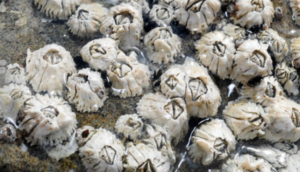 When you think crustaceans, you could probably come up with crabs and lobsters and shrimp without too much prompting. But a creature you might not consider right away is the barnacle. That’s right, those little guys you see attached to the side of ships are actually crustaceans. There are around 1220 species of barnacle knows currently (filling a tank for all of those creatures would be the dream of any water supply company), and of those, the most popular is the acorn barnacle, shown above. Barnacles are all sessile, which means that they are immobile, and attach themselves to other, larger objects with a super-sticky glue. This fast-curing cement that they produce is one of the most effective glues in the natural world, and, in fact, known to man. Having a tensile strength of 5000 pounds per square inch, it’s no wonder people are looking at a way to harvest it and use it commercially.
When you think crustaceans, you could probably come up with crabs and lobsters and shrimp without too much prompting. But a creature you might not consider right away is the barnacle. That’s right, those little guys you see attached to the side of ships are actually crustaceans. There are around 1220 species of barnacle knows currently (filling a tank for all of those creatures would be the dream of any water supply company), and of those, the most popular is the acorn barnacle, shown above. Barnacles are all sessile, which means that they are immobile, and attach themselves to other, larger objects with a super-sticky glue. This fast-curing cement that they produce is one of the most effective glues in the natural world, and, in fact, known to man. Having a tensile strength of 5000 pounds per square inch, it’s no wonder people are looking at a way to harvest it and use it commercially.
Barnacles will attach themselves to all sorts of things, including underwater volcanoes, boats, and even living things, such as whales. Because of the way they feed, they prefer docking places where there is lots of activity. They feed using appendages called cirri, which are essentially their limbs. They use these long, feathery cirri to attract and trap prey such as plankton and bring it in towards their mouths. Surrounding a barnacle’s body are six plates, used primarily for protection, and four of them can be moved aside to allow the barnacle to feed, and then can also be quickly shut if they sense danger. Barnacles will also close the plates when the tide goes out, which allows them to conserve moisture.
Interestingly, most barnacles are hermaphrodites, which means it’s a free-for-all fertilization fest with neighbours (okay, so that might be a bit of an exaggeration, but I couldn’t resist the alliteration). Apparently, barnacles are more likely to be inclined to be females when they have recently molted. Because they can’t move, a long tube that holds the sperm (which is essentially the penis) extends out from the one barnacle to fertilize another. Fun fact: it’s thought that barnacles have the longest penises in the animal kingdom. They can reach up to extraordinary lengths of six to eight inches, which, considering that barnacles range from around 0.4 inches to 2.7 inches, is really quite impressive. Barnacles can also do a thing called spermcasting, which is essentially exactly what it sounds like: males just chuck sperm into the water and the females grab it and fertilize their eggs. Not the most romantic, but hey, if it works.
The life span of a barnacle is typically 5-10 years, but some have been known to live longer. Barnacles are most vulnerable to predators in the early stages of their lives, when they are floating around without a protective shell and having not yet attached themselves to anything. The whelk, which is a kind of sea snail, is a particularly problematic predator of the barnacle, primarily because they can grind through the barnacle’s exoskeleton and get at the soft, fleshy bits inside. Certain types of starfish can also cause them some problems, and barnacle larvae are known to fall prey to mussels.